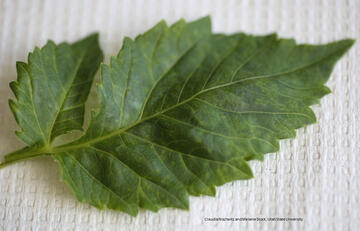Elkhart, Indiana, USA
May 5, 2022
Agdia, Inc. is pleased to announce the launch of a rapid molecular diagnostic test for the detection of Dahlia mosaic virus (DMV) and Dahlia common mosaic virus (DCMV). In addition to the do-it-yourself (DIY) test kit, detection of these pathogens is now offered as a service in Agdia’s Testing Services division for customers who wish to submit plant samples to an ISO 17025-accredited laboratory.
Dahlia mosaic virus (DMV) is the causal agent of dahlia mosaic disease and a member of the Caulimovirus genus. In addition to DMV, a second Caulimovirus, Dahlia common mosaic virus (DCMV), was identified in direct association with disease symptomology. Like DMV, DCMV is a circular, double-stranded DNA virus. Neither virus is limited to a geographical region, and both pathogens are widespread in cultivated dahlias, with mixed infections being common.
Transmission of both viruses occurs via mechanical means (grafting, propagation cuttings, etc.). Furthermore, both viruses are transmitted in a non-persistent or semi-persistent manner by aphids after feeding on infected plants.
Symptoms vary by cultivar but typically include random chlorophyll loss (chlorosis), vein clearing, necrotic lesions, leaf distortion and general stunting. Stunting of the plant often inhibits or prohibits flowering, rendering plants unmarketable. Some cultivars can exhibit mild symptoms or remain asymptomatic indefinitely. Early and accurate detection of DMV and DCMV is paramount to management of these viruses throughout dahlia cultivation.
Agdia’s new AmplifyRP® XRT assay for detection of DMV and DCMV is based on recombinase polymerase amplification (RPA). This technology promotes the rapid amplification and detection of nucleic acid targets, DNA or RNA, while maintaining a single operating temperature of 39–42 °C. The AmplifyRP® XRT products achieve sensitivity and specificity comparable to PCR, while having clear advantages over the lab-based technology. AmplifyRP® XRT products do not require a nucleic acid purification step; crude sample extracts are prepared using a simple extraction buffer and tested directly. When paired with Agdia’s AmpliFire® isothermal fluorometer, the XRT system is a user-friendly tool that can be implemented in the field or the lab by personnel with limited experience in molecular diagnostics. Total assay time is less than 30 minutes when used with the AmpliFire® as a real-time assay.

Fig. 2: Symptoms caused by Dahlia mosaic virus.
Photo provided courtesy of Claudia Nischwitz and Melanie Stock, Utah State University.
Agdia states their new assay was validated against a diverse panel of DMV/DCMV isolates from multiple geographic regions, detecting all true positives. Sensitivity for this assay is comparable to that observed with published conventional PCR, qPCR and LAMP assays to which it was compared. Furthermore, this product exhibited a high level of exclusivity against a comprehensive panel of potential cross reactors, including Carnation etched ring virus, Cauliflower mosaic virus, Chrysanthemum stunt viroid, Cucumber mosaic virus, Dahlia latent viroid, Impatiens Necrotic Spot Virus, Potato virus Y, Rudbeckia flower distortion virus, Tobacco streak virus and Tomato Spotted Wilt Virus. This assay does not detect the endogenous pararetroviral element (DMV-D10). This assay includes an endogenous internal DNA control and was developed to be used with flower, leaf, petiole, root, seed, stem and tuber tissue.